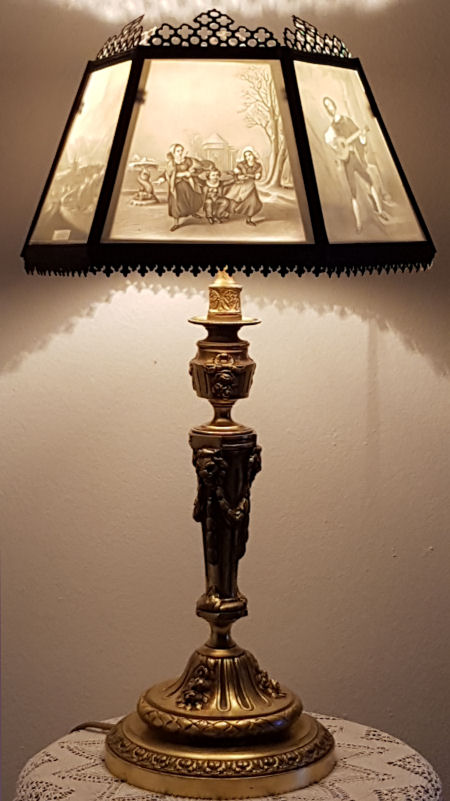 A beautiful table lamp with a bronze base and a lampshade consisting of six trapezoidal lithophans. |
A lithophane is a three dimensional image which is
carved or moulded in a thin translucent material and only can be viewed properly when lighted
from behind. Originally the lithophanes were made of porcelain. When viewed in a normal reflected light the only thing that strikes you is that the porcelain is of various thicknesses, but when you place a light behind the porcelain, the picture impressed into it comes to life and the full details are revealed in vivid grey tones and in three dimensions. This is caused by the various thicknesses of the porcelain. The thinner the parts the more light comes through, while the thicker portions hold back the light and appear to be darker. Litophanes functioned among others in candle shields, night lights, lampshades, fire screens, and veilleuse-théières (tea warmers) and were also hung in windows as a light catcher. Sometimes lithophanes were incorporated into mugs, steins, cups and plates. These had to be lifted to the light to see the picture. |

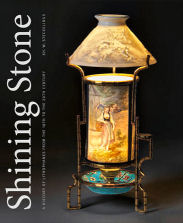 Leuchtender Stein: Die Geschichte Der Lithophanie Vom 18. Bis Ins 20. Jahrhundert (German and English edition). Author: K.H.W. Steckelings. |
| How it started with me: | |
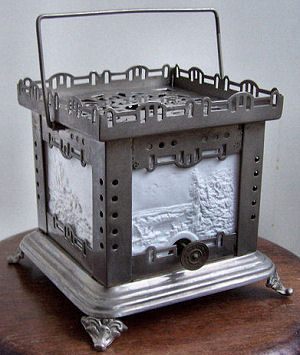 While I was helping
a good friend of mine with her computer problems, she told me incidentally that
she paid a visit to a Handicraft Museum the other day. She told me that she
intended to bring an old tea warmer that once belonged to her mother to that museum.
'It's a wonderful tea warmer.' she said. 'It has four small white porcelain
tiles on all the sides, through which the light shines from the candle inside.' While I was helping
a good friend of mine with her computer problems, she told me incidentally that
she paid a visit to a Handicraft Museum the other day. She told me that she
intended to bring an old tea warmer that once belonged to her mother to that museum.
'It's a wonderful tea warmer.' she said. 'It has four small white porcelain
tiles on all the sides, through which the light shines from the candle inside.' I almost jumped upright from my chair. 'Those small tiles,' I cried, 'those tiles are lithophanes. And I have been looking for those lithophanes for a long time already. Because they are a missing link in my collection of magic lanterns. I'm sure that museum already possesses such a tea warmer. Probably plenty more. So don't bring it to a museum, but grant it to me'. 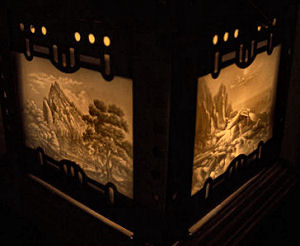 My friend was amused by
my enthusiastic reactions and carefully took the tea warmer from a
cabinet in a corner of the room. It looked very well. It was beautiful. All four
tiles were present and they
were intact as well. The best of all..... I got it from her as a present! 'Anyway I'm sure
that it is at the right place now.' she said. 'I prefer giving it to someone who is very
happy with it and will handle it very carefully than selling it.' My friend was amused by
my enthusiastic reactions and carefully took the tea warmer from a
cabinet in a corner of the room. It looked very well. It was beautiful. All four
tiles were present and they
were intact as well. The best of all..... I got it from her as a present! 'Anyway I'm sure
that it is at the right place now.' she said. 'I prefer giving it to someone who is very
happy with it and will handle it very carefully than selling it.'Immediately after I arrived at home I placed a small waxlight inside the tea warmer. It was fascinating to see how that flickering flame behind the slightly pinkish translucent plaques now revealed the beautiful pictures that were hidden inside them. I knew immediately that it would be the first of many tea lights and that I would definitely go looking for more of that beauty! |
|
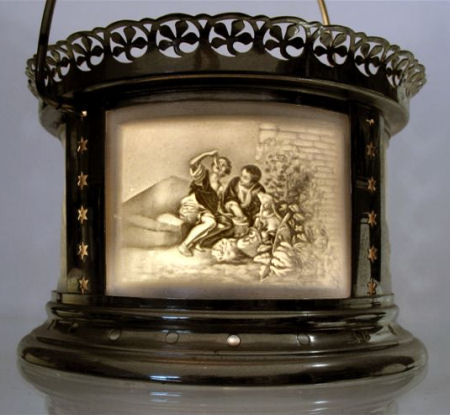 |
 |
|
Two wonderful tea warmers. The porcelain
plates in the smallest one measure only 25 x 35 mm. One of them shows
the fairy tale of Little Red Ridinghood. |
|
| History. |
| European lithophanes were first produced almost simultaneously in France, Germany, Prussia, and England around the later part of the 1820s. Many historians credit Baron Paul de Bourging (1791–1864) with inventing the process of lithophanes in 1827 in France, but others argue that the inspiration for the idea came originally from China nearly a thousand years before during the Tang Dynasty. |
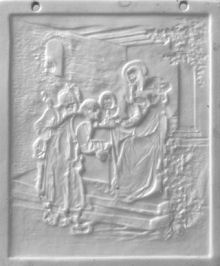 |
 |
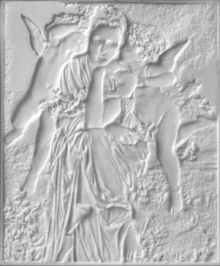 |
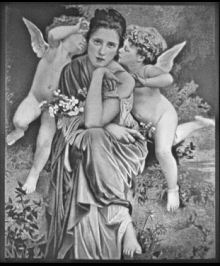 |
| Lithophane showing a couple of beggars and
a rich family. It is of German origin and dates from the late 19th Century.
There is no maker's mark but it is stamped with the number '917'. It measures 4" x 4.75" (10.2 x 12 cm). |
Lithophane with a young woman flanked by
winged cherubs in a beautiful garden. It has no maker's marks but is of German
origin. It dates from the late 19th Century. Dimensions: 3.75" x 4.5" (9.5 x 11.5 cm). |
|
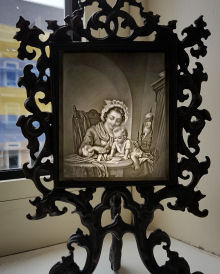
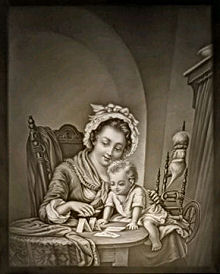 |
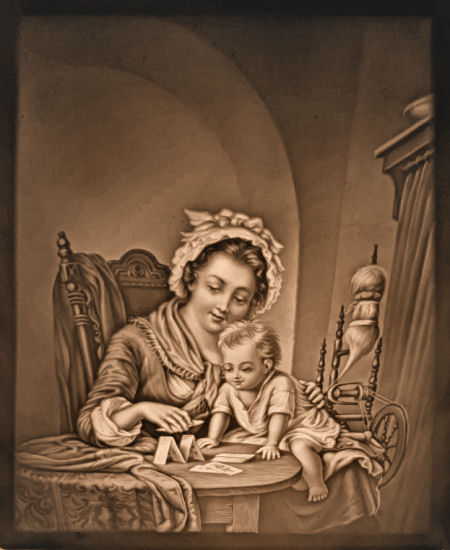 |
|
|
Lithophanes should not be stored in a cupboard, but
must be viewed. Apart from the fact that they often occur in tea warmers for that reason, they can be mounted in an optionally exuberant
decorated or not decorated frame and placed in front of the window, or
as a window hanger hung on a little chain in front of the window. Anyway:
if the light falls from behind, then it is good. That is why stands as on the picture were often
provided with a pullout candle holder at the back. This beautiful lithophane is called 'Das Kartenhaus'. |
||
| Some manufacturer's marks on lithophanes: | ||
| - The mark "Ad'T" on lithophanes from
Rubles, near Melun in France. Probably the mark of Baron A. de Tremblay. - H.P.M. Hennebergsche Porzellan Manufaktur Gotha, Thuringa. - P.P.M. Prensaich Porzellan Manufaktur in Plaue. - B.P.M. Berlin Porzellan Manufaktur. - K.P.M. Koniglichen Preussische Manufaktur. - Mod Dep P.R. Modèle Déposé, indicating these images have legal French Trademark protection. About 25 factories in Belgium, France, Denmark, Portugal, England, Italy, and Czechoslovakia produced lithophanes. Some well-known companies involved in lithophane production were the Wedgwood and Worchester Potteries in England, Phoenix Pottery in Pennsylvania, Beleek in Ireland, and Limoges in France. |
Lithophanes never bear the signature of an artist. However, the manufacturer's mark and a design number are often found on the reverse of the plaque. Probably it was rather unfair for each of the artists to have signed the work as there were so many people involved in the making of this complex art object. | |
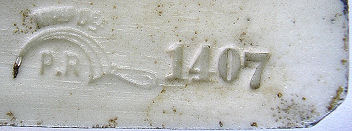 |
||
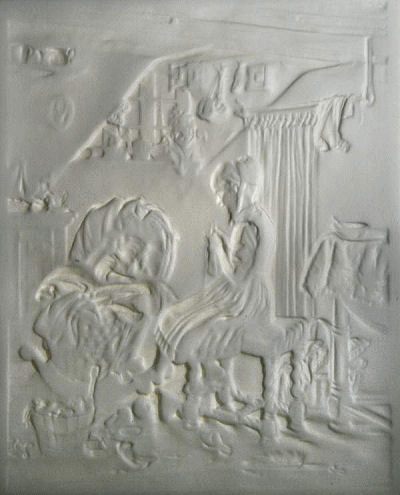 Maman et Berceau. Mother and cradle. Antique lithophane of a really stunning beauty. The animation shows this lithophane both unexposed and with backlighting. |
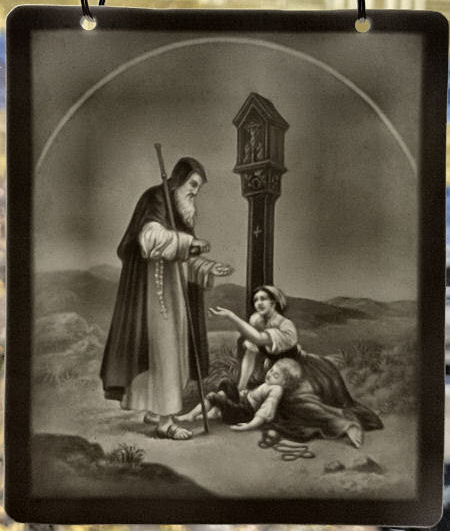 'Der Wöhltätige Pilger' after a painting or engraving by Eduard Daege. Window hanger on small chains. |
|
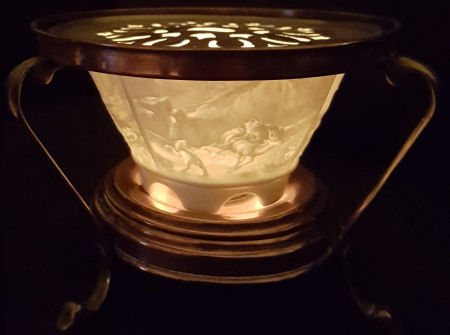 Above a copper tea light with a conical lithophane and on the right a chrome-plated light with four rectangular landscape lithophanes. |
 |
|
| Manufacturing the lithophanes. | ||
The very first lithophanes were individually carved entirely by hand, but
shortly after their introduction, the artists realised that moulds could be
made, from which numerous pieces could be cast. Artists of the highest rank made the master dies
in which a fine porcelain biscuit
could be moulded and after that fired in the kilns.
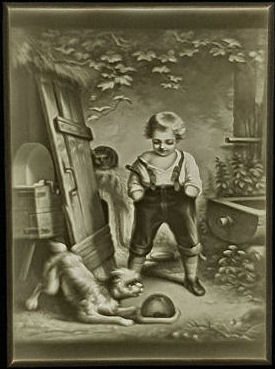 The
artist used a thin sheet of bee wax which was on a piece of plate glass. The sheet of wax
had a completely flat surface and the same transparency as the lithophane would have at completion.
Sometimes the carving table was near a window and had a mirror below the table
to provide constant light for carving. The artist meticulously had to take away
exactly enough wax to cause the variations of shades and lights and darks that made the
picture. This picture could be a painting, a print, an etching, or a photograph;
all two dimensional pictures, so the artist not only had to reproduce the
details of the picture, but he also had to carve it in relief for depth as well
as for shading. This carving would have been extremely difficult. The
artist used a thin sheet of bee wax which was on a piece of plate glass. The sheet of wax
had a completely flat surface and the same transparency as the lithophane would have at completion.
Sometimes the carving table was near a window and had a mirror below the table
to provide constant light for carving. The artist meticulously had to take away
exactly enough wax to cause the variations of shades and lights and darks that made the
picture. This picture could be a painting, a print, an etching, or a photograph;
all two dimensional pictures, so the artist not only had to reproduce the
details of the picture, but he also had to carve it in relief for depth as well
as for shading. This carving would have been extremely difficult.When the artist had finished his work on the wax, a plaster of Paris mould was made from the wax mould and this became the master die. The porcelain dough was poured into that mould and when the water had been sufficiently evaporated from the dough it was removed from the mould and placed into a porcelain oven for firing. Up to about 60% of the thin tiles would warp or crack in the kiln causing them to become useless. Most lithophanes stayed in an unglazed state, but some of them are glazed, which takes an additional firing, and some have colour applied. The majority of lithophanes are made of white porcelain, although some have a sepia shade. Others have a slight greenish tinge and a very few have an almost mauve shading. This is due to the characteristic of the clays used. For colouring them a transparent enamel for porcelain is applied on the lithophanes that had to be baked another time after that. |
||
| Coloured lithophanes. | ||
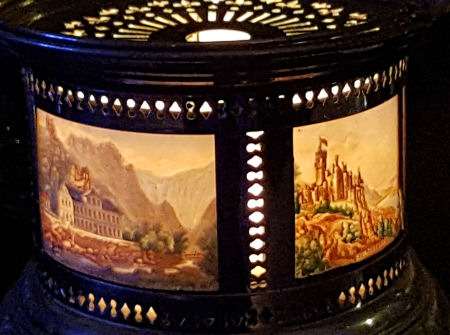 |
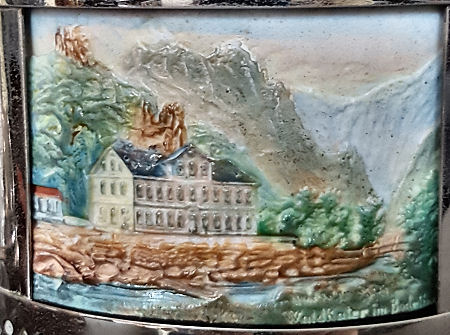 |
|
| Round chrome-plated tea light with petroleum burner. Inside four curved landscape lithophanes, all hand coloured. | ||
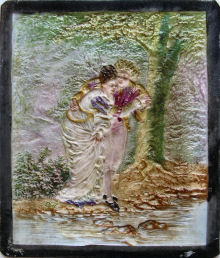 |
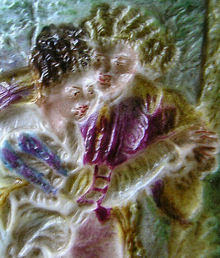 |
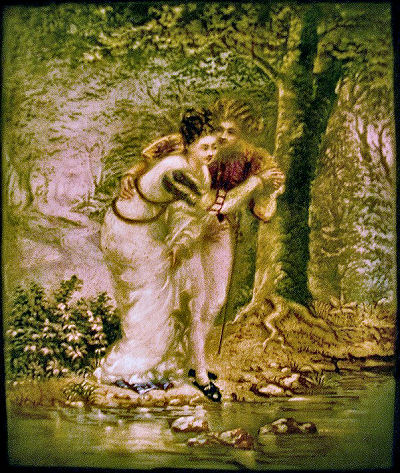 |
|
The colours are often garish
and not at all agreeable when viewed with reflected light, but with the
transmitted light the colours become soft, diffused, and extremely pleasing. Hand painted bisque porcelain lithophane in black enamelled rim border (c. 1850). It measures approximately 4" x 4.5" (11.5 x 10 cm). |
||
 |
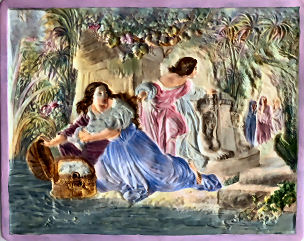 |
|
Two marvellous
lithophanes with images of the little Moses who is found in the wicker basket. This pair of lithophanes was made by the Plaue (Schierholz) factory. The dimensions are about 21 x 17 cm. |
| Lithophanes nowadays. | ||
| Lithophanes became less popular by 1900, and by the 1930s were hardly made at
all. However, recently there have been some companies that have started making
them again. So be careful when you buy an 'antique' lithophane at a jumble sale. It is said that a company in Durham now makes them in white chocolate. |
||
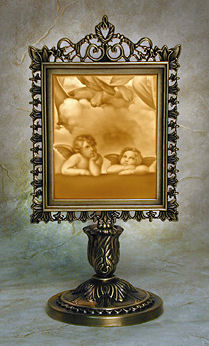 |
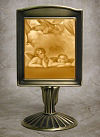
 |
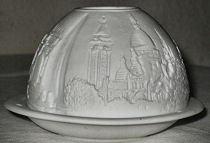
 |
|
Raphael's Angels. One of a large variety of night lamps offered in a lot of gift shops in various designs: Victorian lamp , Mantle lamp, or Cherry shadow box lamp. |

Paris at Night. |
|
| One of a large variety of votive lights made in the town of Limoges by the Bernardaud family. A wax light placed beneath the dome beautifully illuminates a lovely Paris scene. | ||
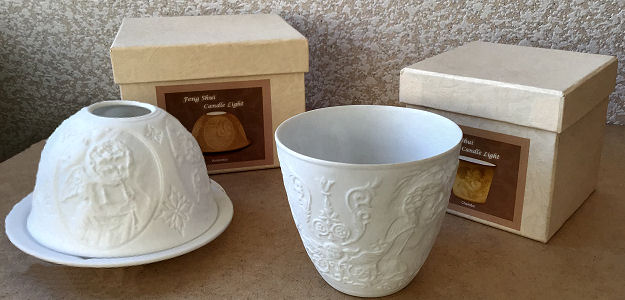 |
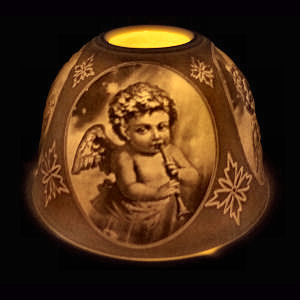 |
|
|
Two examples of atmospheric lights that are sold nowadays in
spiritual shops. |
||
|
The blossoming of the 3D printer has greatly simplified the production of
lithophanes. As a result, more and more companies are
entering the market, and at sites like E-bay also private individuals appear who
produce lithophanes on the basis of a by the customers supplied photo. The lithophanes can be supplied as a cube-shaped light with five different lithophanes at the sides (see photos), flat, curved or as a cylinder, in the form of a lampshade or window hanger. The modern 3D technique makes it all possible. |
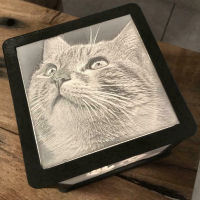
 |
| Crockery with lithophanes. | ||
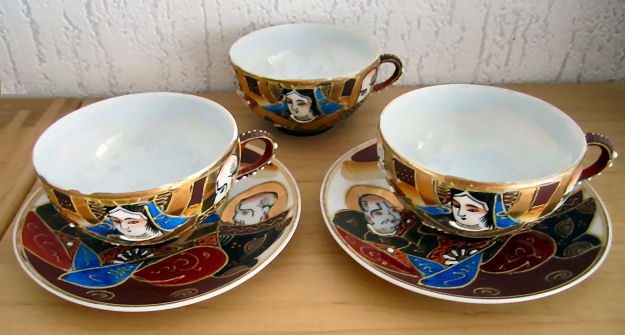 |
 Beautiful decorated Japanese tea cups. When a cup is hold against the light we see a Geisha head depicted at the bottom. |
|
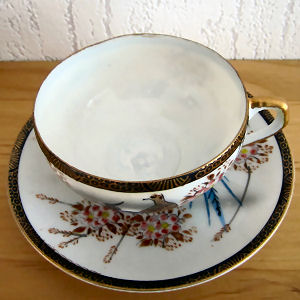 |
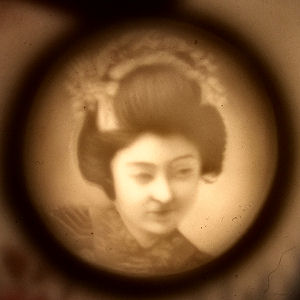 |
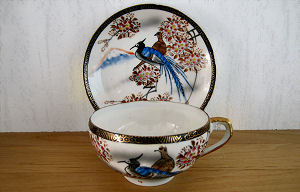 Also this beautiful decorated tea cup has a lithophane of a Geisha at the bottom. |
 |
 Beautifully painted beer mug with as an extra surprise on the bottom a lithophane with the image of a young boy milking a goat. |
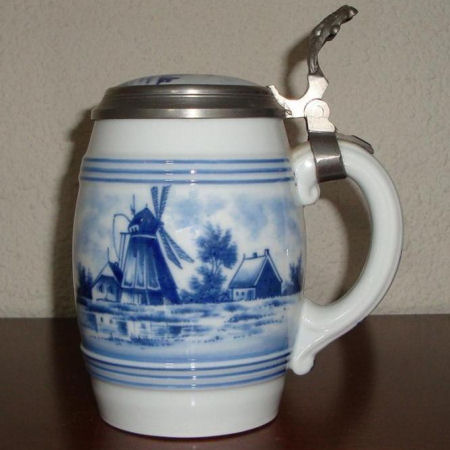 |
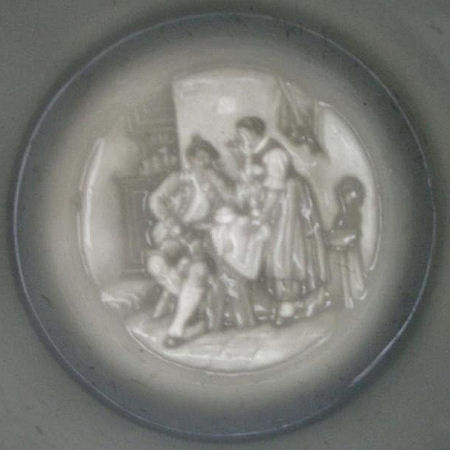 |
 |
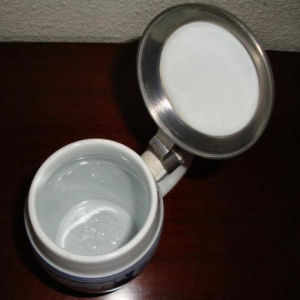 |
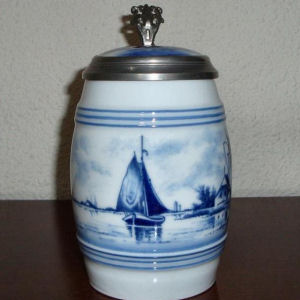 |
|
Delftware beer mug that has a wonderful lithophane at the
bottom. It is decorated with Delft Blue paintings that picture typical Dutch
landscapes with mills and sailing boats. |
||
|
Do it yourself. On 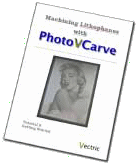 the internet a lot of computer software and carving hardware can be found that allows you to
make your own lithophanes from translucent materials in quite a simple process. the internet a lot of computer software and carving hardware can be found that allows you to
make your own lithophanes from translucent materials in quite a simple process.For instance 3 mm (1/8") thick white Plexiglas is very suitable for the process. The ideal material to machine lithophanes into is 1/4" (6 mm) white Corian, which is a synthetic solid surface material manufactured by DuPont. To machine a smooth high quality lithophane a Ball Nose cutter should be used. Generally speaking, the smaller the design the smaller the cutter diameter is required to ensure the maximum detail is machined into the piece. The larger the cutter diameter the less detail will be achieved. |
The film can not be viewed on every browser. |
| Nowadays, usually a 3D printer is used to make a lithophane. For this purpose a lot of software is available that can be used to make a lithophane at home. It is also possible to send a photo to a specialized company, which then makes it a lithophane. | |
 |
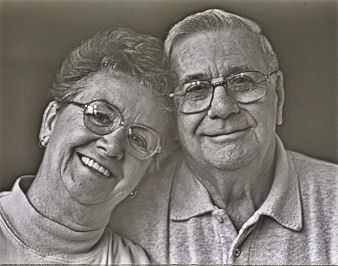 |
| A lithophane that was made from a photograph and the result when lighted from reverse. | |
More lithophanes..... |
|
| |
©1997-2023 'de Luikerwaal' All rights reserved. Last update: 17-05-2023. |
|